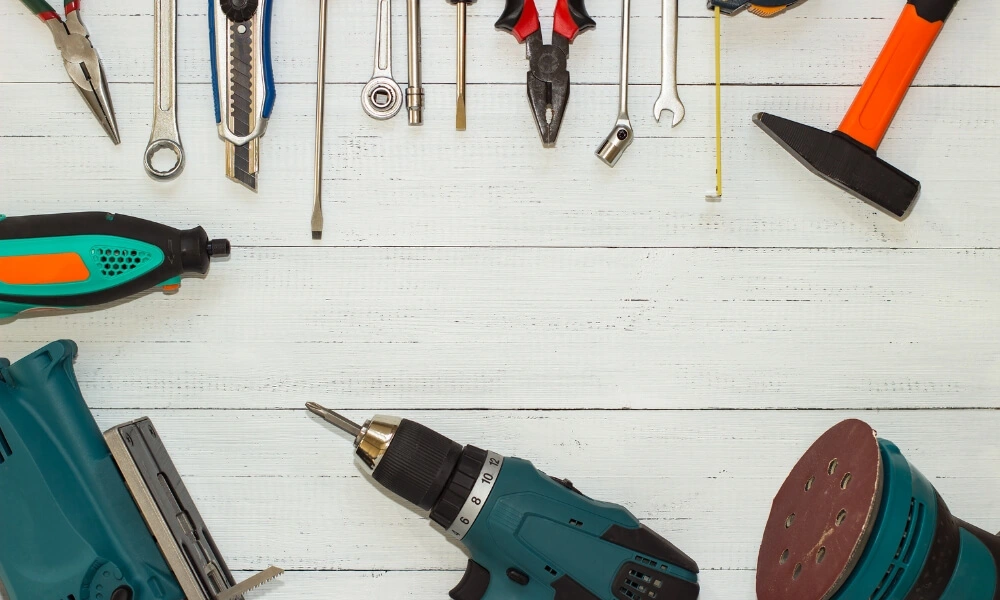Safety should always be a top priority when working with power and hand tools. These tools can potentially make tasks easier and more efficient, but they also come with inherent risks. To ensure your well-being and protect yourself from potential hazards, you must equip yourself with the right Personal Protective Equipment (PPE).
In this blog, we will explore the 10 essential PPE types you should consider when operating power or hand tools. Whether you’re a professional tradesperson, a DIY enthusiast, or someone new to the world of tools, understanding and utilizing appropriate PPE can significantly reduce the risk of injuries and create a safer working environment.
We will delve into each type of PPE, explaining its purpose, the potential risks it mitigates, and how it enhances your overall safety. From eye and face protection to respiratory gear, hand and foot protection, and more, this comprehensive guide will empower you to make informed decisions about the PPE you need for different tool applications.
Power Tools and Hand Tools
Power and hand tools are tools used for various tasks, including construction, woodworking, metalworking, DIY projects, and maintenance work. Here’s a brief explanation of each:
Power Tools
Power tools are tools that operate using an external power source, such as electricity, batteries, or compressed air. They are designed to make tasks easier, faster, and more efficient. Power tools often incorporate motors or engines to generate power and can be categorized into several types, including:
- Drills: Used for drilling holes in various materials.
- Saws: Used for cutting through materials such as wood, metal, or plastic.
- Sanders: Used for smoothing or shaping surfaces.
- Grinders: Used for cutting, grinding, or polishing tasks.
- Routers: Used for hollowing out an area or creating decorative edges.
- Nail Guns: Used for driving nails into surfaces quickly.
- Impact Wrenches: Used for tightening or loosening bolts and nuts.
- Power Screwdrivers: Used for driving screws into surfaces efficiently.
These are just a few examples of power tools, and there are many more specialized tools available for specific tasks.
Hand Tools
Hand tools are tools that are powered by manual force and do not require an external power source. They are operated by hand and often rely on mechanical advantage or physical exertion. Hand tools are typically versatile, portable, and widely used in various industries and applications. Some common hand tools include:
- Hammers: Used for striking or driving nails, chisels, or other objects.
- Screwdrivers: Used for turning screws.
- Wrenches: Used for turning nuts and bolts.
- Pliers: Used for gripping, bending, or cutting objects.
- Saws: Hand-operated saws used for cutting through different materials.
- Chisels: Used for carving, shaping, or cutting hard materials.
- Files: Used for smoothing, shaping, or removing material from surfaces.
- Measuring Tools: Tools like tape measures, rulers, and levels are used for measuring and marking.
Hand tools offer precision, control, and versatility for a wide range of tasks and are often essential in combination with power tools.
Both power tools and hand tools have their specific advantages and are used depending on the nature of the task, available resources, and personal preference. It’s important to use these tools safely and with the appropriate personal protective equipment (PPE) to minimize the risk of injuries.
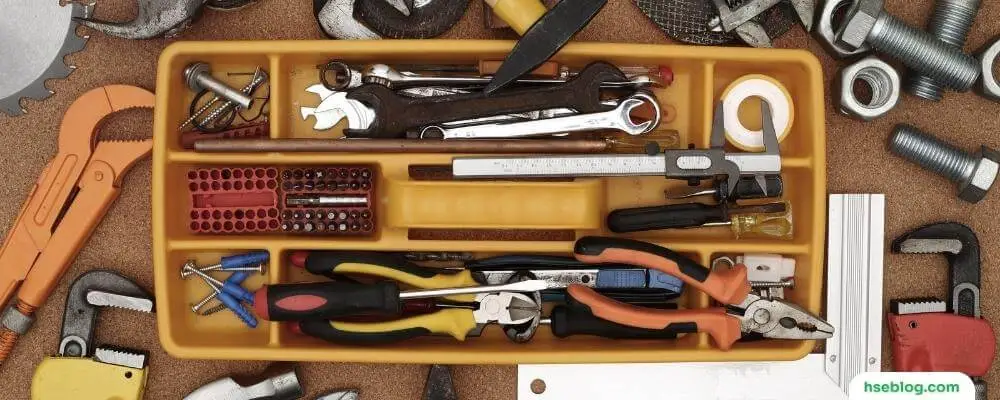
Importance Of PPE For Power Tools and Hand Tools Use
Personal Protective Equipment (PPE) plays a vital role in ensuring safety when using power tools and hand tools. Here are some key reasons why PPE is important in this context:
- Injury Prevention: PPE is a physical barrier between the user and potential hazards, reducing the risk of injuries. It protects various body parts from cuts, impacts, burns, electrical shocks, and other potential dangers associated with power tool safety and hand tool usage.
- Eye and Face Protection: Power tools can generate flying debris, sparks, or dust that can cause serious eye injuries. Wearing safety glasses or a face shield helps prevent eye damage and ensures clear vision during work.
- Hearing Protection: Power tools often produce loud noises that can lead to hearing loss or damage. Wearing earplugs or earmuffs attenuates the noise levels, safeguarding your hearing health.
- Respiratory Protection: Some power tools create dust, fumes, or airborne particles that can be harmful when inhaled. A respirator or dust mask filters out these contaminants, preventing respiratory or long-term health problems.
- Hand and Foot Protection: Power tools and hand tools involve handling sharp or rotating components. Wearing safety gloves provides protection against cuts, abrasions, or punctures. Safety shoes with toe caps and metatarsal guards shield your feet from heavy objects, impacts, or accidental crushing, offering an additional layer of protection in hazardous work environments.
- Head Protection: Hard hats protect from falling objects, overhead hazards, or accidental bumps. They minimize the risk of traumatic head injuries, such as concussions or skull fractures.
- Chemical and Heat Protection: When working with power tools that involve chemicals or heat, appropriate PPE, such as gloves, aprons, or fire-resistant clothing, is necessary to protect the skin from burns, chemical spills, or corrosive substances.
- Confidence and Peace of Mind: Wearing proper PPE instills confidence and peace of mind while operating power and hand tools. It allows you to focus on the task, knowing that you have taken necessary precautions to protect yourself.
Remember, PPE should be selected based on the specific hazards associated with the tools, the work environment, and the manufacturer’s recommendations. Regular inspection, maintenance, and proper usage of PPE are essential for its effectiveness in safeguarding your well-being during tool usage.
PPE For Power Tools and Hand Tools
Personal Protective Equipment (PPE) is crucial when using power and hand tools to ensure safety and prevent injuries. Here are 10 types of PPE commonly used in such situations:
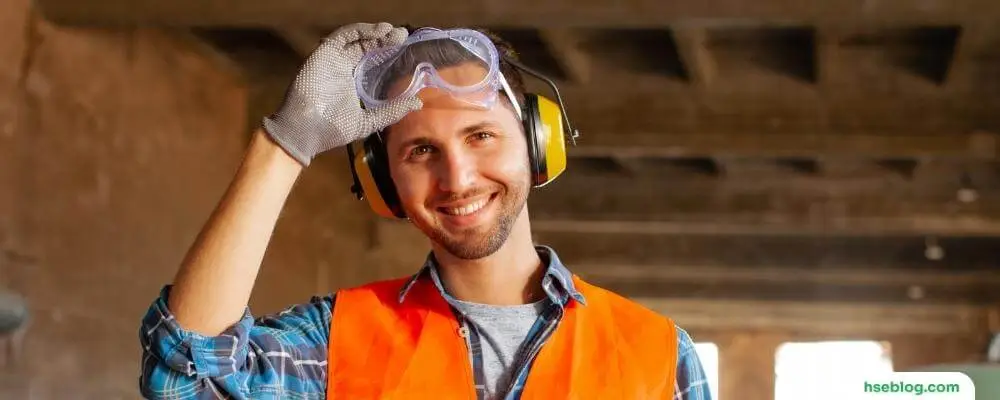
1. Safety Glasses
Safety glasses are essential for personal protective equipment (PPE) when working with power and hand tools. They play a crucial role in protecting your eyes from potential hazards and injuries during various tasks.
When using power tools, such as drills, saws, or grinders, safety glasses provide a physical barrier between your eyes and any flying debris, wood chips, metal fragments, or dust that may be generated. These tiny particles can easily cause eye injuries, ranging from minor irritation to severe damage. Safety glasses with side shields provide additional protection by preventing debris from entering your eyes from the sides.
Hand tools, including hammers, chisels, screwdrivers, and wrenches, also pose risks to your eyes. While the potential for high-velocity projectiles is lower compared to power tools, accidents can still happen. Pieces of metal, wood, or other materials can splinter, break, or fly off unexpectedly, endangering your eyesight. Safety glasses are an effective safeguard against such hazards, minimizing the risk of injury.
When selecting safety glasses for power tools and hand tools, there are a few key factors to consider:
- Impact resistance: Look for safety glasses that meet or exceed the impact resistance standards set by relevant safety organizations. ANSI Z87.1 certification is a common standard to ensure proper protection against impacts.
- Lens material: Polycarbonate lenses are popular for safety glasses as they are lightweight, durable, and highly impact-resistant. They also provide excellent optical clarity, allowing you to see without distortion.
- Fit and comfort: Proper fit is crucial to ensure adequate eye protection. Choose safety glasses that fit securely on your face and provide a comfortable wearing experience. Adjustable nose pads and temples can enhance comfort and ensure a customized fit.
- Anti-fog and scratch resistance: Look for safety glasses with anti-fog and scratch-resistant coatings. These features help maintain clear vision by preventing fogging from perspiration or temperature changes and protect the lenses from scratches, ensuring long-term durability.
Remember, safety glasses should be worn whenever you are working with power tools or hand tools, regardless of the duration or complexity of the task. Protecting your eyes should be a priority to prevent potential injuries and maintain optimal vision while working in potentially hazardous environments.

2. Ear Protection
Ear protection is another crucial component of personal protective equipment (PPE) when working with power tools and hand tools. Exposure to excessive noise levels can lead to hearing damage and long-term hearing loss. Therefore, wearing appropriate ear protection is vital to safeguard your hearing health.
Both power and hand tools can generate high noise levels during operation. Power tools like drills, saws, sanders, and grinders produce loud and continuous noise. In contrast, hand tools such as hammers, pneumatic, and power nailers can also create significant noise levels, especially in confined spaces.
There are several types of ear protection available, including:
- Earplugs: These are small inserts that are inserted into the ear canal to block or reduce noise. They come in different sizes and materials, such as foam, silicone, or wax. Earplugs provide a comfortable fit and are convenient to carry, making them suitable for various work environments.
- Earmuffs: Earmuffs consist of two ear cups connected by an adjustable headband. The cups are filled with sound-absorbing materials to reduce noise levels. Earmuffs offer good protection against high-frequency noise and provide a better seal around the ears, making them effective in environments with high noise levels or when using particularly loud power tools.
- Disposable earplugs with earmuffs: This combination provides enhanced protection, combining the advantages of earplugs and earmuffs. The earplugs are inserted into the ear canal, and the earmuffs are worn over them to provide additional noise reduction.
When selecting ear protection, consider the following factors:
- Noise reduction rating (NRR): The NRR measures how much noise the ear protection device reduces. Look for earplugs or earmuffs with a suitable NRR to adequately protect the noise levels in your work environment.
- Comfort and fit: Choose ear protection that fits well and feels comfortable during extended periods of use. Ill-fitting or uncomfortable ear protection may be ineffective and discourage consistent usage.
- Compatibility with other PPE: Ensure that the chosen ear protection doesn’t interfere with other PPE, such as safety glasses or hard hats, and can be worn simultaneously without compromising safety.
Remember, consistent and proper usage of ear protection is essential for maintaining your hearing health. Always wear ear protection when operating power tools or working in noisy environments to reduce the risk of hearing damage and preserve your long-term auditory well-being.

3. Respirator
A respirator is a vital piece of personal protective equipment (PPE) when working with power tools and hand tools, especially in environments where airborne particles, dust, fumes, or gases are present. It protects your respiratory system by filtering out harmful substances and ensuring you breathe clean air.
Power tools, such as sanders, grinders, and saws, can generate a significant amount of dust and particles that can be hazardous to your health if inhaled. Likewise, certain hand tools, like paint sprayers or pneumatic tools, may produce fumes or airborne chemicals that can be harmful when breathed in.
When selecting a respirator for power tools and hand tools, consider the following:
- Types of respirators: There are two primary respirators: disposable respirators (often called dust masks) and reusable respirators (such as half-face or full-face respirators). Disposable respirators are typically used for short-term or single-use applications, while reusable respirators offer longer-term protection and are suitable for frequent use.
- Filtration efficiency: Look for respirators with appropriate filtration capabilities for the hazards you will likely encounter. Different respirators are designed to filter out specific particles or substances, such as dust, aerosols, or gases. The respirator’s rating indicates filtration efficiency, such as N95 for dust or particulate filtration or cartridges with specific chemical or gas filtration capabilities.
- Fit and seal: A proper fit and seal are crucial for a respirator to provide effective protection. Ensure the respirator fits securely over your nose and mouth and forms a tight seal against your face. This prevents contaminated air from bypassing the filter and entering your respiratory system.
- Comfort and usability: Choose a respirator that is comfortable to wear for extended periods. Adjustable straps, cushioning, and lightweight designs can enhance comfort and encourage consistent usage. Additionally, consider the ease of use, such as the ability to don and doff the respirator quickly and efficiently.
- Maintenance and cleaning: Reusable respirators require regular cleaning and maintenance to ensure their effectiveness. Check the manufacturer’s instructions for proper cleaning procedures and replace filters or cartridges as recommended.
It’s important to note that respirators are not suitable for all situations. In some cases, ventilation or other engineering controls may be necessary to reduce airborne hazards. Assess the specific hazards of your work environment and consult relevant safety guidelines to determine the appropriate respiratory protection required.

4. Dust Mask
A dust mask, also known as a disposable respirator, is a type of respiratory protection commonly used when working with power and hand tools in dusty environments. It is designed to filter out particles and airborne contaminants, protecting your respiratory system from inhaling harmful substances.
Dust masks are particularly useful in situations where the primary concern is the inhalation of dust, such as woodworking, construction, or metalworking tasks. They are lightweight, inexpensive, and easy to use, making them a popular choice for short-term or occasional use.
Here are some key points to consider when using a dust mask:
- Filtration efficiency: Dust masks are available in different filtration levels, typically indicated by their NIOSH (National Institute for Occupational Safety and Health) rating. The most common rating for dust masks is N95, which filters out at least 95% of airborne particles. Some masks, such as N99 or N100, may have higher filtration ratings, providing even greater protection against fine particles.
- Proper fit: To ensure effective protection, it is essential to achieve a proper fit with the dust mask. Follow the manufacturer’s instructions for wearing the mask correctly, including positioning it over your nose and mouth and adjusting the nose clip or metal band to create a tight seal. The mask should fit snugly against your face without gaps or leaks.
- Single-use nature: Dust masks are typically designed for single-use and should not be reused or shared between individuals. Dispose of used masks properly according to local regulations and guidelines. Avoid touching the front of the mask during use, as it may become contaminated with particles.
- Limitations: Dust masks have limitations and are not suitable for all hazards. They primarily protect against solid particles and may not provide adequate protection against gases, vapors, or certain chemicals. If you work with substances that produce fumes or gases, consult relevant safety guidelines to determine if additional respiratory protection, such as a respirator with specific cartridges or filters, is required.
- Comfort and breathability: Look for dust masks that are comfortable to wear, with adjustable straps or ear loops that ensure a secure fit without causing discomfort. Consider masks with built-in exhalation valves, which can help reduce heat and moisture buildup, improving breathability during extended periods of use.
Remember, dust masks are intended for low-level dust exposure and should be used with other safety measures, such as proper ventilation, dust collection systems, or work area enclosures, whenever possible. Assess the specific hazards of your work environment and follow relevant safety guidelines to determine the appropriate respiratory protection needed to ensure your well-being.
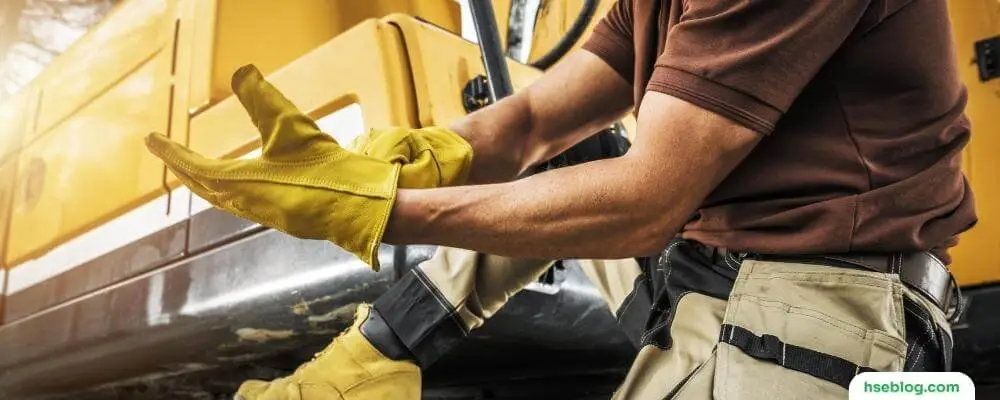
5. Safety Gloves
Safety gloves are an essential piece of personal protective equipment (PPE) when working with power tools and hand tools. They provide an extra layer of protection for your hands, helping to prevent injuries such as cuts, abrasions, punctures, and burns. Safety gloves come in various materials and designs, each suited for specific tasks and hazards. Here are some important considerations when choosing safety gloves for power tools and hand tools:
- Material: Safety gloves can be made from different materials, including leather, synthetic materials like nylon or neoprene, and specialized fabrics. Leather gloves are durable and provide excellent protection against cuts and abrasions, making them suitable for heavy-duty tasks. Synthetic gloves are often more flexible and resistant to chemicals and oil, making them ideal for tasks involving solvents or greasy materials.
- Grip and Dexterity: When working with power tools or hand tools, it’s crucial to maintain a firm grip and retain dexterity. Look for gloves with textured surfaces or coatings that enhance grip, allowing you to confidently handle tools. Additionally, choose gloves that provide enough flexibility and dexterity, enabling you to manipulate small parts or operate controls effectively.
- Cut Resistance: Power tools, such as saws or rotary tools, pose a significant risk of cuts and lacerations. Ensure that the gloves you select have a high level of cut resistance, typically indicated by a cut-resistant rating, such as ANSI/ISEA cut levels. These ratings range from A1 to A9, with higher levels offering better protection against cuts.
- Impact Protection: Some power tools, like jackhammers or pneumatic tools, can generate significant vibrations or impacts. Consider gloves that incorporate padding or specialized materials in areas vulnerable to impact, such as the knuckles or the back of the hand. These gloves can help reduce the risk of hand injuries and minimize the effects of repetitive impacts.
- Heat Resistance: Power tools, such as welding or cutting tools, produce heat that can cause burns if proper precautions are not taken. If you work with tools that generate high temperatures, select gloves with heat-resistant properties. These gloves are typically made from Kevlar or aluminized fabrics and can withstand elevated temperatures without degrading.
- Size and Fit: Safety gloves should fit well to ensure optimal protection and comfort. Ill-fitting gloves can impair dexterity and increase the likelihood of accidents. Choose gloves that come in different sizes and consider trying them on before making a purchase. A snug but not tight fit is ideal, allowing for flexibility and ease of movement.
- Maintenance and Replacement: Regularly inspect your safety gloves for signs of wear, such as fraying, cuts, or holes. Replace damaged gloves promptly to maintain their protective properties. Additionally, clean and maintain your gloves as the manufacturer recommends to prolong their lifespan and ensure their effectiveness.
Remember, safety gloves are just one part of the safety measures you should take when working with power and hand tools. Always follow proper safety procedures, wear appropriate eye protection, and use other necessary PPE, such as hearing protection or respiratory masks, depending on the specific hazards associated with your tasks.

6. Safety Shoes
Safety shoes are a critical component of personal protective equipment (PPE) when working with power tools and hand tools. They are designed to protect your feet from various hazards, including falling objects, sharp or heavy tools, electrical shocks, and slips or trips. Here are some key features to consider when selecting safety shoes for working with power tools and hand tools:
- Toe Protection: Safety shoes typically feature toe caps made of steel, aluminum, or composite materials. These toe caps provide impact resistance and protect your toes from falling objects or compression injuries. Look for safety shoes with toe caps that meet the required safety standards for your work environment.
- Slip Resistance: Power tools and hand tools can create slippery surfaces, especially when combined with liquids, oils, or debris. Slip-resistant soles are essential for maintaining stability and reducing the risk of falls. Safety shoes with outsoles made of materials like rubber or polyurethane often provide good traction and grip on various surfaces.
- Electric Hazard Protection: When working with power tools, there is a potential risk of electrical hazards. Safety shoes with electric hazard protection are designed to provide insulation against electrical currents. These shoes feature non-conductive materials in the sole and heel, reducing the risk of electric shock.
- Comfort and Fit: Safety shoes should be comfortable to wear for extended periods to prevent fatigue and discomfort. Look for shoes with cushioned insoles, breathable materials, and adequate arch support. Proper fit is also crucial for comfort and safety. Choose safety shoes that offer different sizes and widths, and try them on before purchasing to ensure a good fit.
- Durability: Power tools and hand tools can subject your shoes to considerable wear and tear. Select safety shoes made from durable materials, such as leather or synthetic materials designed for industrial use. Reinforced stitching and additional protective features, like reinforced heel counters or ankle support, can enhance the durability and longevity of the shoes.
- Waterproof or Water-Resistant Properties: Depending on your work environment, it may be beneficial to choose safety shoes with waterproof or water-resistant properties. These shoes can help keep your feet dry and protected in wet conditions, reducing the risk of discomfort, fungal infections, or cold-related injuries.
- Compliance with Safety Standards: Ensure that the safety shoes you choose comply with the relevant safety standards and regulations in your industry or work environment. Look for shoes that meet or exceed standards such as ASTM F2413 (USA) or EN ISO 20345 (Europe). These standards define the minimum requirements for protective footwear, including impact resistance, toe protection, and electrical hazard protection.
Regular inspection and maintenance of safety shoes are essential to ensure their effectiveness. Check for any signs of damage, such as worn outsoles, loose stitching, or compromised toe caps, and replace them as needed. Clean your safety shoes regularly to remove dirt and debris, as accumulated materials can affect their slip resistance and durability.
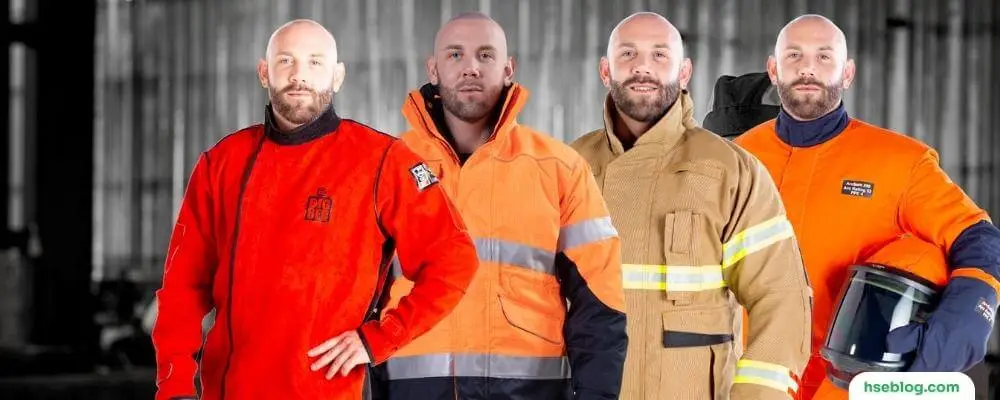
7. Protective Clothing
Protective clothing is an essential component of personal protective equipment (PPE) when working with power tools and hand tools. It serves to shield your body from various hazards such as cuts, abrasions, impacts, sparks, and chemicals. Here are some key considerations when selecting and using protective clothing for working with power tools and hand tools:
- Work-specific Clothing: Choose clothing suitable for your work’s specific tasks and hazards. For example, if you work with power tools that generate sparks, consider wearing flame-resistant clothing. If you work with chemicals, select clothing that provides chemical resistance. Assess the potential risks and choose appropriate protective clothing accordingly.
- Material: Protective clothing is available in various materials, each with its specific properties and suitability for different tasks. Common materials used in protective clothing include cotton, polyester, nylon, denim, leather, and specialized fabrics with chemical or flame-resistant properties. Consider the durability, comfort, breathability, and protection the materials offer when selecting your clothing.
- High-Visibility Clothing: Wearing high-visibility clothing is crucial if you work in environments with moving machinery or areas with low visibility. High-visibility clothing is typically brightly colored (e.g., fluorescent orange or yellow) with reflective stripes, making you more visible to others and reducing the risk of accidents.
- Fit and Comfort: Protective clothing should fit well and allow for ease of movement. Loose or baggy clothing can pose a safety risk by getting caught in machinery or hindering movement. Ensure that your clothing provides a comfortable fit without compromising safety.
- Protection for Extremities: Consider wearing additional protective gear besides your main clothing for your extremities. For example, wearing long-sleeved shirts or coveralls can protect your arms from cuts, burns, or chemical splashes. Similarly, wearing long pants or specialized work pants can protect your legs.
- Protective Aprons or Smocks: If you work with tools or materials that can cause splashes, spills, or staining, consider wearing protective aprons or smocks. These garments can help protect your clothing from damage and prevent substances from coming into direct contact with your skin.
- Maintenance and Replacement: Regularly inspect your protective clothing for signs of wear, tear, or damage. Replace any damaged or worn-out garments to maintain their effectiveness. Follow the manufacturer’s guidelines for cleaning and maintenance to ensure that your protective clothing remains in good condition.
- Layering: In some cases, it may be necessary to layer protective clothing to provide enhanced protection. For example, you might wear flame-resistant clothing as a base layer and add additional protective layers, such as a chemical-resistant apron or a high-visibility vest.
- Personalization and Identification: Personalizing or identifying your protective clothing may be helpful in certain work environments. This can include labeling your clothing with your name or employee identification number or using color-coded garments to differentiate between work areas or roles.
Remember, protective clothing is just one part of a comprehensive safety program. Always follow proper safety protocols, receive training on the safe use of tools, and use other necessary PPE, such as safety glasses, gloves, helmets, or respiratory protection, depending on the specific hazards associated with your work.

8. Hard Hat
A hard hat is a vital piece of personal protective equipment (PPE) when working with power tools and hand tools, particularly in construction, industrial, or other hazardous work environments. It provides essential head protection against falling objects, impacts, electrical hazards, and other potential risks. Here are some key considerations when it comes to hard hats:
- Construction and Design: Hard hats are typically constructed with a hard outer shell made of durable materials like high-density polyethylene (HDPE) or thermoplastic. The outer shell is designed to absorb and distribute the force of impacts. Inside the hard hat is a suspension system that helps absorb shocks and provides a comfortable fit. Look for hard hats that meet the required safety standards for your industry or work environment.
- Type and Class: Hard hats come in different types and classes, each suited for specific levels of protection and work environments. The type refers to the level of protection against impacts, while the class indicates additional features, such as electrical insulation. For example, Type I hard hats protect against blows to the top of the head, while Type II hard hats provide additional protection against lateral impacts. The appropriate class will depend on the potential electrical hazards in your work environment.
- Suspension System: The suspension system inside the hard hat is crucial in providing a secure and comfortable fit. It consists of adjustable straps, headbands, and a cradle that helps evenly distribute the hard hat’s weight evenly. Look for an adjustable suspension system that provides a snug fit and allows for ventilation to enhance comfort during prolonged use.
- Proper Fit: A properly fitted hard hat is essential for effective protection. Ensure the hard hat fits snugly on your head without being too tight or loose. Most hard hats come with adjustable suspension systems to accommodate different head sizes. Adjusting the straps and headbands to achieve a secure and comfortable fit is important.
- Chin Straps: In situations where there is a risk of the hard hat falling off or being dislodged, such as working at heights or in windy conditions, it may be necessary to use a chin strap. Chin straps help keep the hard hat securely in place and prevent it from falling off in case of sudden movements or accidents.
- Inspect and Replace: Regularly inspect your hard hat for signs of damage, such as cracks, dents, or any visible wear and tear. Even minor damage can compromise the effectiveness of the hard hat. If you notice any damage, replace the hard hat immediately. Follow the manufacturer’s recommendations for the lifespan of the hard hat, as they may have specific guidelines on when to replace it.
- Additional Accessories: Depending on your work environment and specific hazards, additional accessories may be available for hard hats. These can include accessories such as face shields, earmuffs, or safety goggles that attach to the hard hat. These accessories provide additional protection for your face, eyes, and ears while ensuring compatibility with the hard hat’s design and safety standards.
Remember, a hard hat should always be worn with other appropriate PPE, such as safety glasses, hearing protection, safety gloves, and protective clothing, to ensure comprehensive protection while working with power and hand tools. Follow proper safety procedures, receive training on tool usage, and be aware of potential hazards in your work environment to minimize the risk of accidents and injuries.
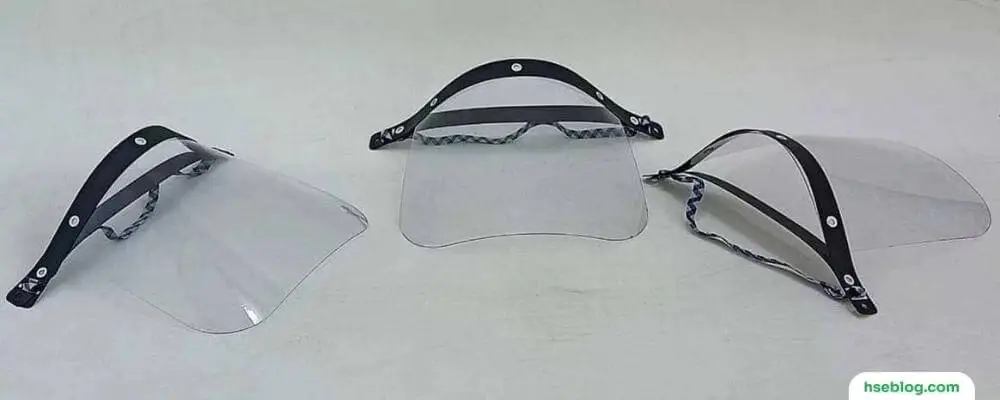
9. Face Shield
A face shield is an important piece of personal protective equipment (PPE) when working with power tools and hand tools. It protects the face and eyes against flying debris, sparks, chemical splashes, and other potential hazards. Here are some key considerations when it comes to face shields:
- Construction and Design: Face shields consist of a transparent visor made of materials like polycarbonate or acrylic. These materials are chosen for their impact resistance and optical clarity. The visor should provide a wide field of vision and cover the entire face, extending from the forehead to below the chin.
- Compatibility and Attachments: Face shields are designed to be compatible with various headgear, such as hard hats or safety helmets. Look for face shields that securely attach to your existing headgear or with an integrated headband or suspension system. This ensures a stable and comfortable fit during use.
- Protection Level: Face shields are available in different protection levels, depending on the potential hazards in your work environment. Some face shields are designed to provide basic impact protection, while others offer additional features such as resistance to chemicals, ultraviolet (UV) light, or heat. Choose a face shield that provides the appropriate level of protection for your specific tasks and hazards.
- Proper Fit: A well-fitting face shield should cover the entire face without obstructing vision or causing discomfort. Adjustable headbands or suspension systems allow customization and ensure a secure fit for different head sizes. It is important to adjust the face shield to sit at the correct position on the head, ensuring proper protection.
- Compatibility with Other PPE: Face shields should be compatible with other necessary PPE, such as safety glasses or goggles. Some face shields have built-in goggles or can be worn over prescription eyewear, providing additional eye protection. When using face shields with safety glasses or goggles, ensure no interference with the fit or visibility.
- Maintenance and Cleaning: Regularly clean your face shield according to the manufacturer’s instructions. Use mild soap, water, or approved cleaning solutions to remove dirt, debris, or chemical residues. Inspect the face shield for any signs of damage, such as cracks, scratches, or loss of transparency. Replace the face shield if it becomes damaged or compromised.
- Additional Considerations: Depending on your work environment, you may need additional features or accessories for your face shield. For example, anti-fog coatings or ventilation may be necessary to prevent fogging and maintain clear visibility during work. Assess your tasks’ specific hazards and requirements to determine whether additional features or accessories are necessary.
Remember, a face shield is just one component of a comprehensive safety program. Always follow proper safety protocols, receive training on the safe use of tools, and wear other necessary PPE, such as gloves, safety shoes, or protective clothing, depending on the hazards associated with your work.
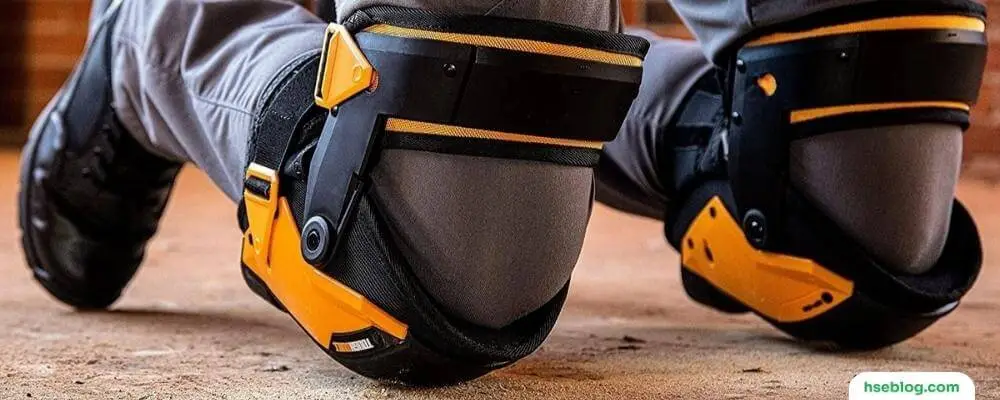
10. Knee Pads
Knee pads are an essential piece of personal protective equipment (PPE) when working with power and hand tools, particularly in tasks that involve kneeling or working on hard surfaces. They provide cushioning and protection for the knees, helping to prevent injuries such as bruises, strains, and knee joint issues. Here are some key considerations when it comes to knee pads:
- Construction and Design: Knee pads are typically made of durable materials such as foam, gel, or rubber. The padding material should offer sufficient cushioning to absorb impacts and reduce knee pressure. Look for knee pads with a tough outer shell that provides resistance against abrasion and punctures. The design should allow flexibility and ease of movement while securely staying in place during work.
- Comfort and Fit: Knee pads should be comfortable for extended periods to prevent discomfort and promote productivity. Choose knee pads with adjustable straps or fastening mechanisms, allowing you to customize the fit for your knees. The straps should be secure but not overly tight, ensuring the knee pads stay in place without cutting off circulation.
- Size and Coverage: Knee pads come in various sizes to accommodate different leg sizes and provide a proper fit. Select knee pads that cover the entire knee area, including the sides, to ensure comprehensive protection. Knee pads with extended coverage may also offer additional protection for the upper shin area.
- Slip Resistance: When working on slippery or uneven surfaces, knee pads need to have slip-resistant properties. Look for knee pads with textured or non-slip surfaces on the bottom to prevent them from shifting or sliding during work. This helps to maintain stability and reduce the risk of falls or accidents.
- Flexibility and Range of Motion: Knee pads should allow for a good range of motion, enabling you to bend, kneel, and move comfortably. Choose knee pads that are flexible and not overly bulky, as excessive bulk can restrict movement and hinder performance. Knee pads with articulated designs or segmented padding can offer enhanced flexibility and mobility.
- Durability and Maintenance: Knee pads should withstand the demands of the work environment and maintain their protective properties over time. Select knee pads made from high-quality materials resistant to wear and tear. Regularly inspect the knee pads for damage or deterioration, and replace them if worn out or compromised.
- Task-Specific Considerations: Consider the specific tasks you will perform when selecting knee pads. If you work on rough surfaces or encounter sharp objects, choose knee pads with extra durability and puncture resistance. Opt for knee pads with waterproof or chemical-resistant properties for exposure to liquids or chemicals.
Remember, knee pads are an important component of overall safety measures. However, they should not be solely relied upon. Always follow proper safety protocols, practice good ergonomics, and use other necessary PPE, such as safety glasses, gloves, and protective footwear, depending on the specific hazards associated with your work.
Conclusion
In conclusion, when it comes to using power tools and hand tools, prioritizing personal protective equipment (PPE) is paramount. The 10 essential types of PPE discussed in this blog – including safety glasses, ear protection, respirators, gloves, safety shoes, protective clothing, hard hats, face shields, knee pads, and dust masks – are designed to safeguard you from potential hazards, prevent injuries, and promote a safer working environment.
By embracing appropriate PPE, adhering to safety guidelines, and staying informed about best practices, you can confidently pursue your projects, knowing that you have taken crucial steps to protect yourself and those around you. Remember, safety is a responsibility that should never be compromised, so make PPE an integral part of your tool usage routine and prioritize your well-being above all else.

